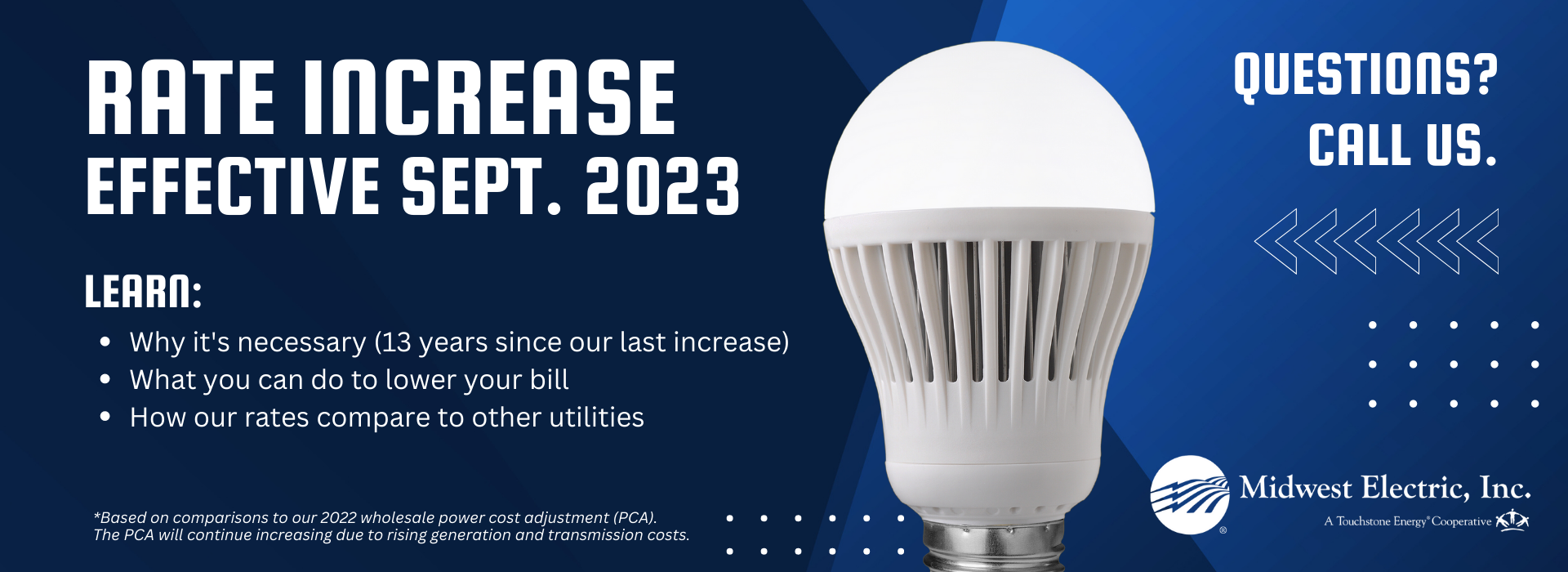
Starting on the bill you receive September 21, 2023, the average residential member will see an increase due to the increased cost to provide power to the members. Click here to see the detailed breakdown. Commercial accounts are being contacted individually.
Why is an increase needed?
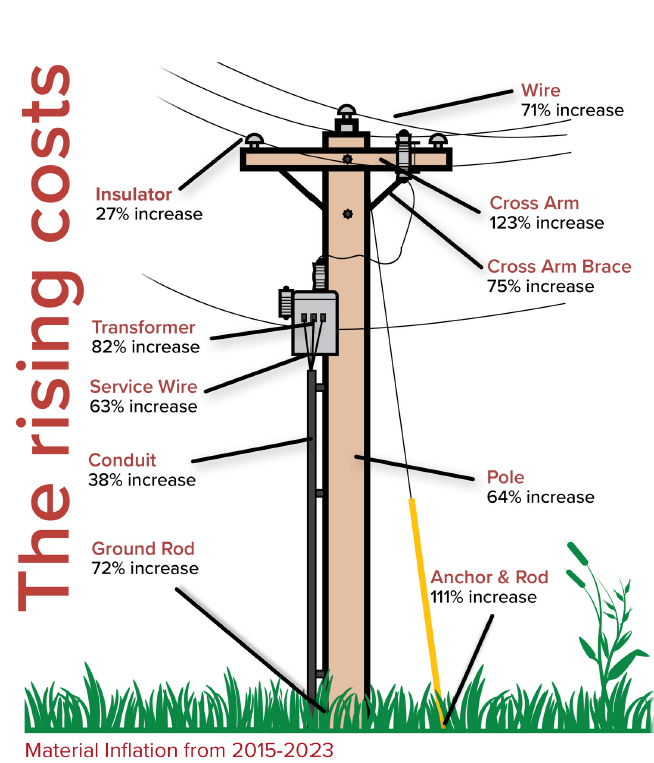
With inflation and rising whole power costs, our costs are increasing faster than our revenue. Our last rate increase was in 2010. Going 13 years without raising rates puts us at risk of having insufficient funds to invest in YOUR electric reliability.
We are not-for-profit and member-owned, so any increase in revenue is only used to re-invest in our system and office operations. Our electric system is valued at $70 million and requires $3-4 million in maintenance and upgrades each year. Those costs are only going up.
For the average residential member, here is the bill impact:
- The flat, monthly service availability charge will increase $10 (from $35 to $45)
- This set charge helps pay for the co-op's fixed costs like meters, wires, poles, transformers, taxes, depreciation, billing, tree trimming, line maintenance, etc. These costs are "fixed" because they are incurred whether or not a single kWh of power is used by the member. We serve only about 6 members per mile of line; other utilities not rural-based serve more than 30 members per mile. We receive much less revenue for our investment.
- It costs over $30,000 to build one mile of single-phase line and $80,000 to build one mile of a three-phase line. It costs about $3 million to build a new substation. Material costs are going up.
- The monthly energy charge will increase by about a 1/2 cent per kilowatt-hour (kWh).
- This charge may go up or down depending on how much electricity you use the prior month. By taking steps to reduce your home's usage (scheduling a free home energy audit for recommendations, installing ENERGY STAR appliances or LED lightbulbs, etc.) you can reduce this charge.
Other ways the residential rate changes may affect your bill:
-
Residential members who use more than 20 kWh in 1 hour will receive a $20 demand charge on their bill. This only affects those with very high usage, like from grain dryers, electric vehicle chargers, pool heaters, etc. So all members can see their monthly demand, we will be printing it on all bills starting in June.
- Members on the reduced rate (geothermal, heat pump, or electric heat) will see a change in the breakdown of the discounted rate. See the drop-down section below for details.
- The standard residential security light is currently $10.50 per month and will increase $1 to $11.50 per month. Those who have their light on a separate pole owned by the co-op currently pay an additional $2 per month, which will increase to $2.50.
Note: We anticipated a rate increase in 2019 but have been able to push it off each year without negatively impacting service. We have reached the point where that is no longer possible, and we hope our members understand that.
**Based on comparisons to our 2022 Wholesale Power Cost Adjustment (PCA). The wholesale PCA will continue increasing due to rising power generation and transmission costs.
Residential kilowatt demand is the highest hourly use from the previous month. Starting in September 2023, only members who use over 20 kWh in one hour will be charged the additional $20 on their next electric bill.
This will not affect the average member's bill with normal usage but may affect those with very high demand from grain dryers, pool heaters, electric vehicle chargers, etc.
Click here to watch a video that explains electric demand.
Electric demand vs energy consumption (aka, the "Energy Charge") can be explained with an automobile analogy.
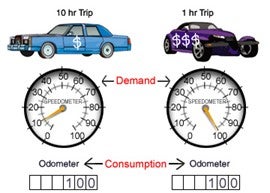
A car's speedometer is like the demand meter; the odometer is like a consumption meter. Two cars could travel the same 100-mile road, one at 10 miles per hour for 10 hours and one at 100 mph for 1 hour. It takes a much more capable and expensive engine to power the sports car running at 100 mph than it does to power the car going 10 mph.
- kW Demand is the highest hourly use from the past month.
- kWh Energy is the total amount used over the entire month
Why are we charging for high demand?
The cooperative must have enough generation and distribution capacity to meet your highest hourly demand. While you don't need that much generation all the time, we have to have it in place and ready to run when you do need it.
Our goal is to offset the demand costs that we pay on our wholesale power bill. It will benefit all members if members take steps to lower their demand.
Find more resources for understanding demand here.
How can I reduce my electric demand?
During times of peak demand (like during a peak alert), here are some simple steps you can take to reduce electricity demand:
- Wait until after 6 pm in the evening to run large appliances, such as washing machines, dryers, and dishwashers.
- Use the microwave or convection oven instead of the oven or range whenever possible.
- Run your pool pump for just 12 hours per day (between the hours of 10 pm to 10 am) instead of around the clock.
- Turn off all the unnecessary lights around your home.
- Set the thermostat on the water heater to a lower temperature.
- Use LED light bulbs.
- Use a programmable thermostat. When properly set, a programmable thermostat can help reduce your heating and cooling costs by up to 10%
- Set your thermostat to 68 degrees Fahrenheit while you’re at home. Lower your thermostat while sleeping.
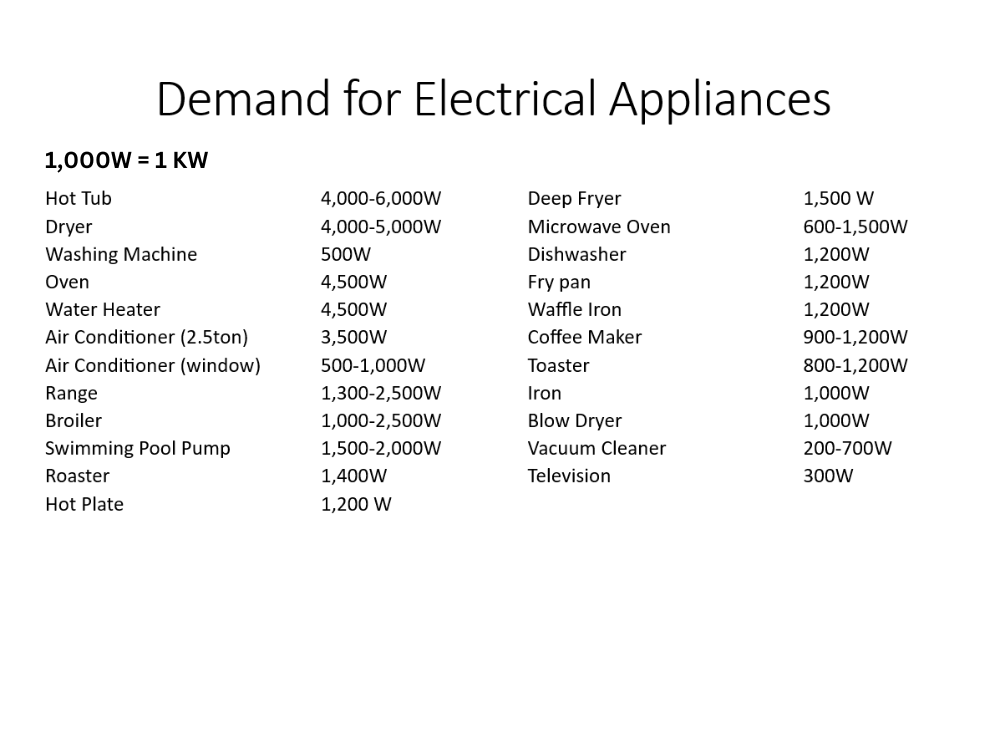
Starting in Sept. 2023, members on the reduced rate (geothermal, heat pump, or electric heat) will see a change in the breakdown of the discounted rate.
Current Reduced Rate (heat pump, geothermal, electric heat)
Service Availability - $35/month
1st 750 kWh $0.0828 per kWh
Next 2,000 kWh $0.0728 per kWh
All remaining kWh are $0.0828 per kwh
This rate is effective 8 months of the year, October through May. From June to September, the standard rate is $0.0828 per kWh.
New Reduced Rate (heat pump, geothermal, electric heat)
Service Availability - $45/month, plus $20 additional (see Standard Rate)
1st 1,000 kWh $0.1004 per kWh
Next 1,000 kWh $0.0904 per kWh
All remaining kWh are $0.1004 per kwh
This rate is effective for all 12 months of the year.
Difference:
The current Reduced Rate is a one-cent discount for 2000 kWh for 8 months (with potential max savings of $160 per year compared to the standard rate).
New Reduced Rate is a one-cent discount for 1000 kWh for 12 months (with potential max savings of $120 per year compared to the standard rate).
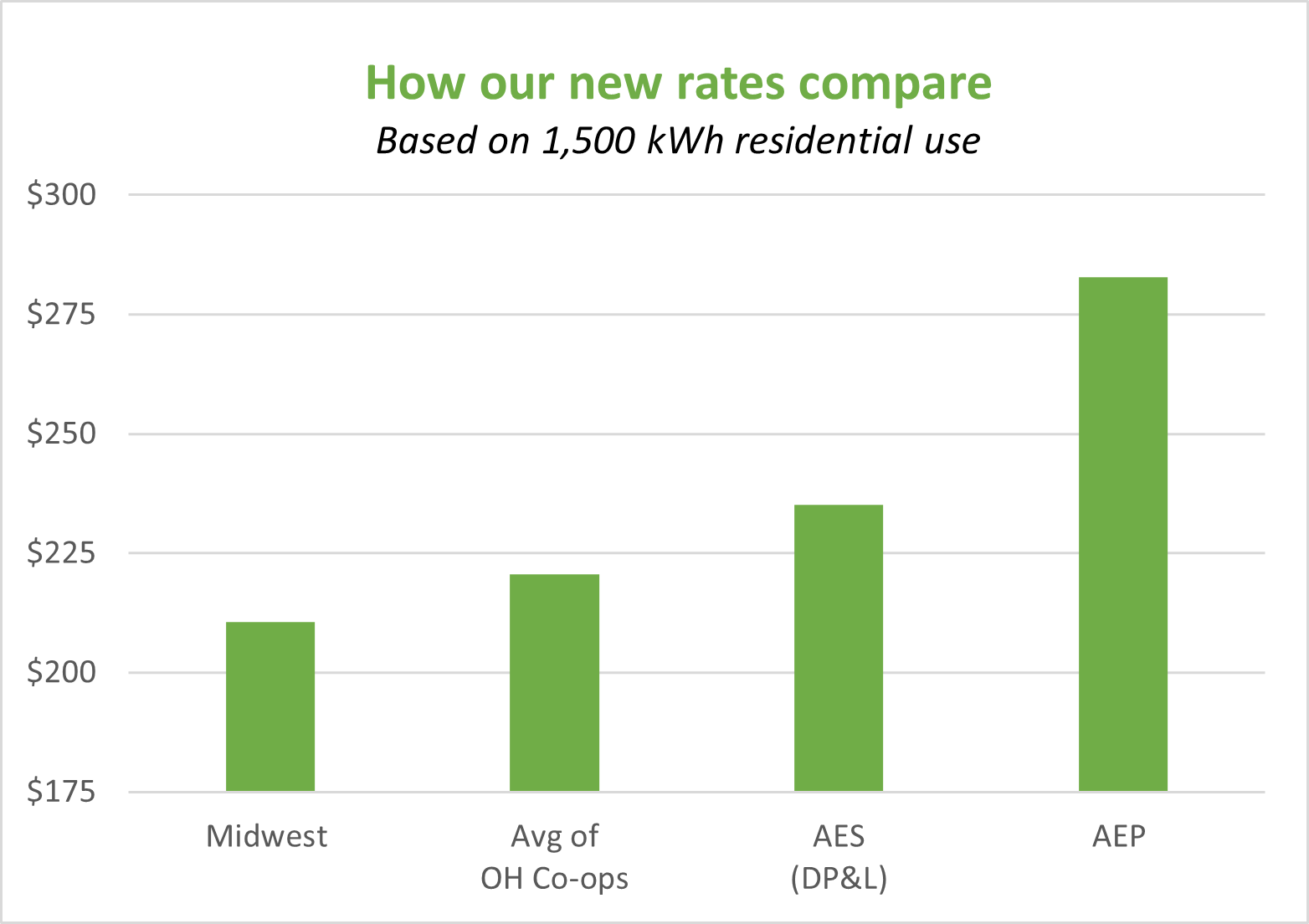
- According to Buckeye Power’s April 2023 report, which uses co-op data and the Public Utilities Commission of Ohio:
- For 1,500 kWh (the average residential co-op member under the new rate effective 9/2023):
- Midwest Electric costs $2.00 less per month than the Ohio co-op average. We are among the lowest cost of all Ohio co-ops.
- Midwest Electric costs $16.00 less per month than DP&L (AES)
- Midwest Electric costs $64.00 less per month than AEP.
- AEP and DP&L have announced double-digit residential rate increases.
- Commercial electric rates are more complicated to compare, and different commercial rates depend on the size of the customer’s load. Generally, our commercial rates are very competitive with all area electric companies.
Other rate increases: Our neighboring utilities, like AEP and AES, have announced rate increases of over 20% in recent months.
-
- Our Wholesale Power Supply comes from Buckeye Power, a not-for-profit cooperative serving Ohio’s 24 distribution cooperatives. We own our own power-generating assets, instead of relying on an unpredictable market. And our fuel generating source is primarily coal – the most economical source.
- Loan Conversions - Converted to lower interest rates, saving hundreds of thousands of dollars in interest expense over the life of the loans. The average interest rate that we pay is less than 4%.
- Competitive bid process for tree trimming, pole testing, and other major projects.
- Load Control - Water heater and air conditioner control switches and commercial account off-peak programs help us save more than $500,000 per year in avoided demand charges.
- Grassroots Lobbying - many examples of fighting for fair legislation and regulations.
- Outsourcing
- Just a few examples include Information Technology; Billing and Member Information software; Dispatching after-hours.
- We have shared services with a neighboring electric cooperative for communications and public relations, meaning we save on not having to hire those employees.
- Purchasing – Our transformers, conductors, etc. are mostly purchased from not-for-profit cooperative-owned supply companies. This keeps costs low.
- Electronic and digital efficiencies; Provides greater member convenience and reduce employee costs.
- 75% of our members pay electronically or automatically.
- Energy library, online energy audits and calculators
- We have email addresses from 80% of our members. Improves office efficiencies as well as member communications.
- Electronic remote deposit –save on bank service fees.
- Payment processing – scans and uploads member payments, rather than manual processing.
- Office and field technologies and work processes are almost all electronic or automated
- Our SmartHub e-bill site provides our members access to everything they need regarding self-management of their account.
- Productivity: We have the same number of employees as we did in the 80s.
- In 1980, we had 30 full-time employees
- In 2023, we have 30 full-time employees
- We have grown annually over the past 40 years, but able to manage it due to the technology and work-flow advancements referenced above, and the high skill level of our employees
We have several free programs and tools to help you control your electric use. Feel free to call us for details, questions, or personalized advice.
- Take advantage of our rebates for energy-efficient upgrades. We also have a reduced electric rate if you have whole-house electric heat, geothermal, or a heat pump. Details apply. Please call us.
- We provide free home energy audits – over the phone, in person, or even online using software. Get details or schedule one here.
- Take advantage of our online energy calculators to help you determine what it costs to run almost everything in your home.
- Switch to AutoPay for a $1 monthly bill credit. Go completely paperless and receive an additional $1 monthly credit.
- Join our Load Management program (Cool Returns) for your electric water heater or air conditioner. This saves the cooperative $500,000 per year!
- Our SmartHub app and online site give you access to monthly, daily, and hourly electric use (watch this YouTube video for instructions). This can help you identify where your energy dollars are going, which could lead to savings. Create your account now.
All commercial accounts have/will receive custom communications for their new rates. It is complex to explain here, but the commercial rate categories will be based on kilowatt-hour usage rather than transformer size. For details, call our office and ask for Joel, or email jjohns@midwestrec.com.
Below are several frequently asked questions for commercial accounts:
-
kW Demand is the maximum amount of electricity consumed at a given time, from the past month. It’s measured in either a 15-minute or 60-minute period, depending on your rate.
-
kW Demand is similar to the speedometer on your car, which tells you how fast you are going at this moment. Compared to kWh Energy is similar to the odometer on your car, which tells how far you traveled (how much you used in total) over the past month. Just like your car has to be built to withstand going 120mph and the engine and component capacity to deliver that speed even though it is rarely needed, we have to build everything to meet your maximum demand. See our demand page here for more details.
You said a 2 percent increase in commercial rates, but my bill went up more than 2%?
-
Our new commercial rates have an increase in the kW Demand charge and a flat or lower kWh Energy charge. This is a reflection of how we are billed from our power supplier.
-
If your bill went up much more than 2% it is because you have a poor load factor. Load factor is a ratio of a consumer’s hourly kW demand, compared to their total kWh energy use. A customer who has a very high demand, but uses relatively low kWh energy, has a poor load factor. This places higher costs on the utility; costs that are not recovered through the low use of energy. Therefore, our new commercial rates will have higher demand charges, but lower energy rates. Many of these consumers can save by changing to our off-peak commercial rate.
What can I do to lower my demand?
-
Call Joel Johns for a personalized review of your facility usage. You should also consider our commercial off-peak program as an option.
Will solar help me?
-
Solar might provide some reduction in your energy use and therefore the kWh Energy part of your bill. But it’s not typical for solar to reduce a facility’s kW Demand. If there is even just one cloudy hour in the month, your facility will still have an electric demand when the solar panels are not operating.
Download the complete FAQ PDF here. If you still have questions or would like clarification on anything, feel free to give our office a call or email info@midwestrec.com.

